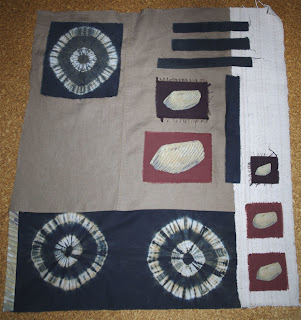My work is inspired by the beautiful, pristine doll's shoes c1890. I thought about the child that would own such a doll and how very different her life as a girl in Victorian England would have been.
Among the other exhibits were some embroidered samplers showing the progress each girl had made in successive years with finer and more complicated stitches. I wondered if the child who owned the doll really wanted to stay at home, stitch and do all that was expected of her.
This first image from my sketchbook shows a photo of Victorian girl's stitching and a modern sampler that I stitched. The capital letter alphabet has the letters 'N' and 'O' in a slightly different colour anf type of thread - a 'comment' that denies the idea of doing as she should. In tiny letters in almost white thread above the alphabet I have stitched the message 'I do not want to sew - I want to see!' 

I started to imagine where her own shoes would have taken her if she had been allowed to travel as she wanted. Her shoes would have marks on the soles to show where she had travelled. I then stitched another page 'Every step you take is a step away from where you used to be'

Istarted researching Victorian women and girls and discovered Isabella Lucy Bird - 1831 -1904, an English traveller who certainly did not stay at home. She travelled the world, including Japan, Korea, Persia, China and Tibet and wrote many books about her often dangerous, but exciting adventures, which are still enjoyed today. She was the first woman to be admitted to the Royal Geographical Society and would have been an inspiration for the child who owned the doll. Below are some more images from my sketch book.


 My final piece will be a pair of children's shoes, showing the dreams of travel and escape that the child who owned the doll, had imagined.
My final piece will be a pair of children's shoes, showing the dreams of travel and escape that the child who owned the doll, had imagined.









































